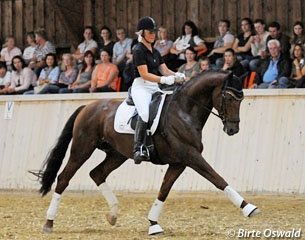
On 12 May 2011 the German Academy of the Horse organized a training seminar with I-judge Christoph Hess and international Grand Pri rider Uta Gräf. Hosted at the Mannheim Riding Club, the event draw a crowd of 300 spectators and was titled “Dressage gymnastics: a source of health for the well ridden horse.”
The title says much, not only about the content of this training seminar, but also about the spirit of the time which reveals that it is no longer obvious that everybody is still aware of the value of the classical method of dressage training and what it has to offer for rider and horse. Classical dressage is based on the knowledge of the old masters, such as Steinbrecht, Bürger, and Seunig among others, with once as aim to build up and keep cavalry horses healthy as long as possible so they would be able to serve on duty.
To follow principles which had been valid for countless cavalry horses and sport horses of Olympic glory may unfortunately be considered “dusty” by some riders, but it is still one of the best ways to maintain the health and willingness to go of every horse. This should be in the interest of all riders, in particular dressage riders who often have to spend a lot of money to find suitable horses.
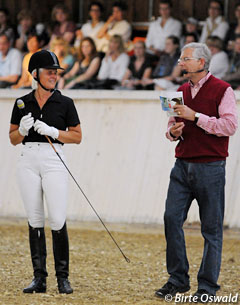 That the classical German method of horse training is one way to good equitation and a healthy horse was shown in Hess' and Graf's clinic in which they used young saddle broken horses as well as fully trained Grand Prix horses as illustration.
That the classical German method of horse training is one way to good equitation and a healthy horse was shown in Hess' and Graf's clinic in which they used young saddle broken horses as well as fully trained Grand Prix horses as illustration.
The tribunes of the indoor arena were bursting with spectators when Peter Hofmann, president of the Riding Club and organiser of the Maimarkt show, welcomed the attendants alongside Christoph Hess. The latter was delighted to see so many interested in the topic, but he jokingly remarked: “I am happy to see so many people here today, but I am aware that most of you came because of Uta Gräf.”
While Hess was responsible for the commentaries, Gräf and several dressage riders from the Mannheim Riding Club, presented horses of different ages and training levels. Gräf's life-partner, veterinarian Stefan Schneider, provided supporting information.
Starting a youngster: No big trots, but maintaining the rhythm
The seminar kicked off with the presentation of a 4-year-old chestnut which had been purchased by the Grimminger family at the Alsfeld auction not long ago. As he was gelded prior to the auction the horse had not yet been ridden a lot and was understandably slightly impressed by the big crowd. Sensitively ridden by Madeline Grimminger the gelding was still a bit inconsistent in his bit contact, nothing unusual for such a youngster, but he showed something which Christoph Hess emphasised to be most important when starting a young horse’s training: a very good cadenced rhythm, the main reason why he was bought by his owners.
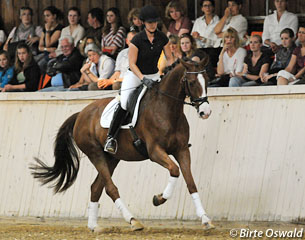 For Hess it’s absolutely essential to pay strict attention to the scale of training: “At the beginning of a young horse’s training the rhythm is most important. One has to be careful not to burden the hind legs of the young horse too much. We see lots of fetlock problems due to this. So don’t exercise big trots, but keep the rhythm of the horse.”
For Hess it’s absolutely essential to pay strict attention to the scale of training: “At the beginning of a young horse’s training the rhythm is most important. One has to be careful not to burden the hind legs of the young horse too much. We see lots of fetlock problems due to this. So don’t exercise big trots, but keep the rhythm of the horse.”
Stefan Schneider confirmed this from his own experiences as a trainer and veterinarian surgeon. In particular horses which tend to kick down in the fetlocks behind are to be monitored closely by doing regular x-rays and by being shod with egg bar shoes.
Building up slowly and systematically a strong back musculature is another aim which has to be followed in the training of a young horse. Here a variety of possibilities is offered to riders and trainers.
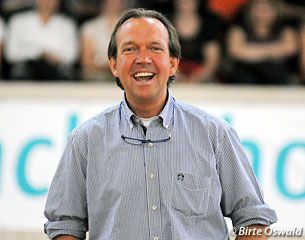 ”We start our youngsters by working them in hand and at the double lunge. Our property is beautifully located in the midst of a hilly forest so first we go walking with them outside in the double lunge. Under the saddle we exercise the young horses very much in walk with given reins to strengthen the back musculature,” Schneider reported on their way of working youngsters.
”We start our youngsters by working them in hand and at the double lunge. Our property is beautifully located in the midst of a hilly forest so first we go walking with them outside in the double lunge. Under the saddle we exercise the young horses very much in walk with given reins to strengthen the back musculature,” Schneider reported on their way of working youngsters.
He strongly advised that in particular young horses have to be outside as much as possible: “The motto has to be ‘keep the horse moving’. The grazing position of a horse is very good and a natural way to stretch its topline.”
The aim of dressage: strengthen the horse, not first and foremost competitions
Uta Gräf demonstrated the concept of "less is more" with the first of the three horses she brought along for the seminar. The 5-year-old Hessian gelding Helios (by the Trakehner Hibiskus out of a Grosso Z- mare) is worked by the 39-year-old for almost 2 years now.
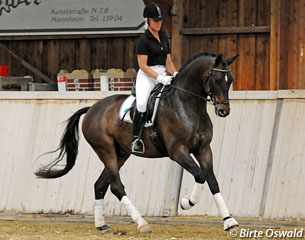 A sympathetic type he is a quality horse for sure, but not the typical big trotter we all know from auctions or the Bundeschampionate classes. For Hess the bay served as a very good example of how training according to the classical principles improves horses. He stated that the aim has to be to strengthen the horse by gymnastic exercises, such as lateral movements, in order to develop its natural possibilities to the maximum.
A sympathetic type he is a quality horse for sure, but not the typical big trotter we all know from auctions or the Bundeschampionate classes. For Hess the bay served as a very good example of how training according to the classical principles improves horses. He stated that the aim has to be to strengthen the horse by gymnastic exercises, such as lateral movements, in order to develop its natural possibilities to the maximum.
The trot is a movement which even very young horses can show in a spectacular way, let alone Grand Prix horses, but do all of them show a true extended trot?
Gräf demonstrated that extending the trot cannot be done by increasing the speed, but by lengthening the steps, beginning from the hind legs which push forward to the front. A true extended trot like that can also be executed by horses with less spectacular, but quality gaits if trained in a correct way.
While he appeared to be already very well muscled and quite mature in his look Helios only made his A- level show debut this year. Gräf explained why she prefers not to start 4-year-olds in dressage competitions: “He is a very willing horse which works motivated and is lots of fun to train as he is also easy to handle. Still I prefer waiting a year longer before competing him in his first A competition. For me its is really important to work a horse on being relaxed and supple, that it moves in a beautiful way and then see how far we get with this. I think the horses reward you if they get more time. For example Helios has won both A classes I started him with very good marks”
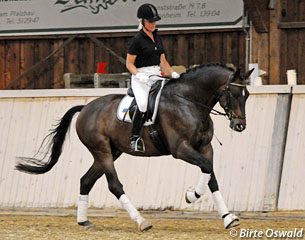 Each time Gräf demonstrated Hess' words on the correct training of a horse, especially of youngsters: “The horses have to stretch to make the back swinging. This swinging is only possible through honest stretching. It is very important for young horses who already work in an uphill collected frame demanded in competitions.”
Each time Gräf demonstrated Hess' words on the correct training of a horse, especially of youngsters: “The horses have to stretch to make the back swinging. This swinging is only possible through honest stretching. It is very important for young horses who already work in an uphill collected frame demanded in competitions.”
Gräf’s gelding, who according to his breeder Dr. Jutta Chirita was “in an indoor arena for the first time in his life”, stretched contently onto the bit in canter at the end of his display. This was rewarded with applause from the crowds. Hess remarked that, “we judges should not only look for technical correct exercises, but we should also communicate with the horse in a way that we pay attention to its body language and what it is expressing. Does it feel comfortable? A horse is not allowed to be subjugated and pressed into a frame by force.”
Though the classical method and its scale of training should be followed, this doesn't mean it's a fixed set of rules. “There’s no general scheme for every horse. Every single one needs its own training programme.” Gräf completely agreed on that: “Every horse is different, so it has to be treated individually. Many of my horses are only ridden 4 times a week. They also go in the aqua horse-walker, are worked in hand and we hack them in the forests.”
Natural horse-keeping and classical training as key factors
The next horse Gräf presented under the supervision of Hess and her partner was the licensed Rhinelander stallion Damon Jerome H (by Ingrid Klimke’s and Helen Langenhanenberg’s Grand Prix horse Damon Hill). This horse was 4th of the World championships for young horses in Verden a year ago and has tremendous quality in its movements.
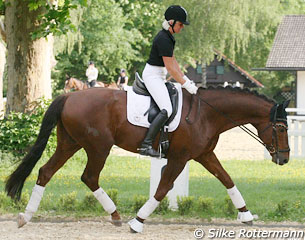 The leggy liver chestnut moves in an extraordinary way, swinging proverbially from top to toe and obviously plays with the tasks given by his rider. For Christoph Hess Damon Jerome represents a dressage talent which likes to present itself and which enjoys moving.
The leggy liver chestnut moves in an extraordinary way, swinging proverbially from top to toe and obviously plays with the tasks given by his rider. For Christoph Hess Damon Jerome represents a dressage talent which likes to present itself and which enjoys moving.
The ease with which the horse showed trot half passes, extended trots and single flying changes in a desireable uphill frame triggered Hess to ask if there isn’t the temptation to ask too much too early of such a super talented horse.
This question is one of paramount importance as the best European breeders produce better dressage horses each year. So the danger lies ahead to abuse the greater talent of dressage horses by forcing the training, the more so as time is money also in a highly professionalised dressage world of today.
Stefan Schneider’s short and clear answer to Hess’ question was, “No! Of course everything’s an easy game for this horse, but we take our time. For this kind of horse it is most important to have a great variety in his training, otherwise he is easily bored. He is hacked, goes into the horse-walker, works in hand and he’s in a big grassy paddock during the day. If you put such a horse 23 hours a day in a box after about 3 weeks you could be easily confronted with cribbing. All of our horses go out in the field or in the paddock during the day. It’s not acceptable to keep horses in the stable for 23 hours. Also dressage horses need to be outside and move as much as possible.”
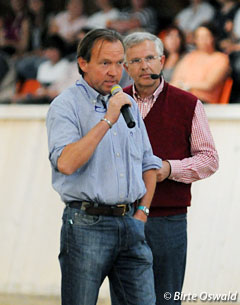 Riding and training according to the classical principles requires a classical seat which is able to support the horse as best as possible. Such a deep seat with hands and calves both quietly feeling the horse could be observed on Gräf with all of her horses. While seated on Damon Jerome she showed the crowds how much she is almost invisibly directing the horse in his way of moving. She gave the horse the reins briefly (“überstreichen”) and the stallion did not change in his uphill frame and continued moving like before.
Riding and training according to the classical principles requires a classical seat which is able to support the horse as best as possible. Such a deep seat with hands and calves both quietly feeling the horse could be observed on Gräf with all of her horses. While seated on Damon Jerome she showed the crowds how much she is almost invisibly directing the horse in his way of moving. She gave the horse the reins briefly (“überstreichen”) and the stallion did not change in his uphill frame and continued moving like before.
Working on the throughness of the horse is another decisive part in the training of dressage horses. This cannot be neglected in favour of practising certain movements if the horse’s training advances over the years. The high rideability of Damon Jerome also became obvious in transitions from walk to trot and back to walk which he executed in copybook-style without any aids by the rider to be detected.
”This is quality equitation. I could watch this for hours,” Hess remarked on a ride which was impressive indeed because it consisted of all what is desired in dressage in general and by the rules of the FEI: a content horse, moving naturally in a frame with the nose slightly in front of the vertical, the poll as the highest point and with a light bit contact.
The classical way is a way to lightness and success
The final outcome of following the classical German method in the training could be admired in the licensed Holsteiner stallion Le Noir. Aged 11 and in his second season at Grand Prix level Gräf’s top horse is a prime example what a horse, which originally was not bred for dressage but with quality gaits, can do.
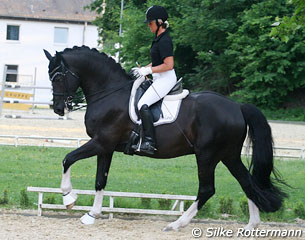
Endowed with a very good jumping pedigree (by Leandro x Caletto I) the magnificent black had been bought by his owners as a foal and was trained up to L / M- level by an amateur before he came to Gräf in February 2008. ”This horse is a very good example what is possible with a horse having a super rhythm,” Hess said about the charming stallion.
Similar to Damon Jerome, Le Noir also shone with extraordinary throughness in the most difficult movements: transitions from walk with given reins to a piaffe and back to walk with given reins were not a big task for him. Hess made clear that even a horse at this highest level can be further improved, for example in the trot work, by exercising shoulder-in-front, shoulder-in and trot half- passes.
The Proof of the Pudding is in the Eating
After presenting several parts of the Grand Prix programme in a traditional double bridle, Gräf switched to a bitless bridle (a kind of padded loose noseband with reins attached to the side rings) and removed her spurs. What was remarkable during that change of equipment was the complete relaxation of a stallion which covers regularly, standing in the middle of a crowded arena while his groom retacked him.
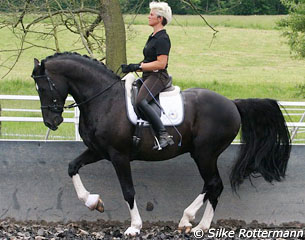 Hess made the striking statement to all present that what they were about to see would be something unique and a true testament to admirable horsemanship. Riding Grand Prix in a bitless bridle is something impossible with many dressage horses because of their wrong training.
Hess made the striking statement to all present that what they were about to see would be something unique and a true testament to admirable horsemanship. Riding Grand Prix in a bitless bridle is something impossible with many dressage horses because of their wrong training.
Gräf rode the most difficult Grand Prix movements such as piaffe, one time flying changes, canter pirouettes and half passes with her horse without a bit.
It was an impressive proof of “a horse carrying itself instead of being carried by the rider” thanks to the right training resulting in true collection and correctly developed impulsion which has not been controlled by a strong bit contact. This could also be seen when Gräf rode an extended canter and brought the horse back only with her seat.
Of course it is wrong and an illusion to claim or believe that following classical principles automatically leads to such an amazing result. In parts this has also become possible because of the horse’s exceptionally willing character and the close relationship Le Noir has with his rider. However this last display made clear that lightness and beauty is possible following the right way in the training of a horse. Simplified it can be expressed as "to respect its natural predisposition and its character and enfold both to its maximum."
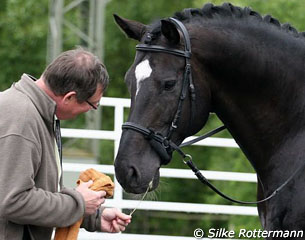 Subsequent to Le Noir’s demonstration Christoph Hess and Uta Gräf were available for questions from the visitors of the seminar.
Subsequent to Le Noir’s demonstration Christoph Hess and Uta Gräf were available for questions from the visitors of the seminar.
During this round one of the questions was raised how the increasingly worsening quality of the training of horses can be stopped. Christoph Hess replied that judges like himself have a great responsibility and have to be clear in their decisions. “Good equitation has to be honoured in competitions.” Gräf agreed: “Many judges recognise good equitation and honour it. I had quite some success at Grand Prix level over the past two years and this would not have been possible without the judges paying attention to the rideability of the horses. The same is valid for the Bundeschampionate.”
The conclusion of three and a half hours of seminar was that classical training of dressage horses, when competently applied, is the key to keeping horses healthy and motivated for many years. However, it has to be complemented with a natural keeping of horses. Lots of movement and freedom and great diversity of scenery (in training). Uta Gräf has given a textbook and encouraging example that if both come together it becomes reality: The happy and successful four-legged athlete.
by Silke Rottermann for Eurodressage.com
Photos © Silke Rottermann - Birte Ostwald
Related Links
Uta Graf and Stefan Schneider, a Kingdom for a Horse
A Day on the Heels of an International Dressage Rider at the 2011 CDI Mannheim
Winter-Schulze and Hess, Recipients of the 2007 Reiter-Forum Award
Hess and Clarke Give Masterclass at 2006 CDI Hartpury